31 Years NEET Previous Year Questions: Health & Disease - 1 - NEET MCQ
23 Questions MCQ Test Biology Class 12 - 31 Years NEET Previous Year Questions: Health & Disease - 1
Match List I with List II : (NEET 2024)
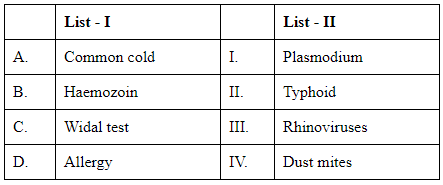
Choose the correct answer from the options given below :

Choose the correct answer from the options given below :
Match List I with List II : (NEET 2024)

Choose the correct answer from the options given below :

Given below are two statements :
Statement I : Bone marrow is the main lymphoid organ where all blood cells including lymphocytes are produced.
Statement II : Both bone marrow and thymus provide micro environments for the development and maturation of T-lymphocytes.
In the light of above statements, choose the most appropriate answer from the options given below (NEET 2024)
Match List I with List II: (NEET 2024)
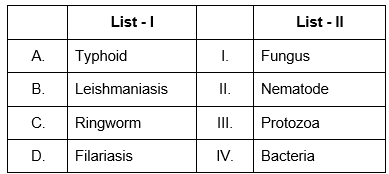
Choose the correct answer from the options given below:
Match List I with List II. (NEET 2023)

Choose the correct answer from the options given below:
Match List I with List II. (NEET 2023)

Choose the correct answer from the options given below:
In which blood corpuscles, the HIV undergoes replication and produces progeny viruses? (NEET 2023)
Select the incorrect statement with respect to acquired immunity. (NEET 2022)
Given below are two statements: (NEET 2022)
Statement I: Autoimmune disorder is a condition where body defense mechanism recognises its own cells as foreign bodies.
Statement II: Rheumatoid arthritis is a condition where body does not attack self cells.
In the light of the above statements, choose the most appropriate answer from the options given below:
Which of the following reasons is mainly responsible for graft rejection in transplantation of organs? (NEET 2022 Phase 2)
Match List-I with List-II [2021]
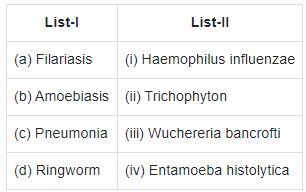
Choose the correct answer from the options given below.

Identify the wrong statement with reference to immunity: [2020]
The infectious stage of plasmodium that enters the human body is: (2020)
Which of the following immune response is responsible for rejection of kidney graft? [2019]
Identify the correct pair representing the causative agent of typhoid fever and confirmatory test for typhoid. (2019)
In higher vertebrates, the immune system can distinguish between self-cells and non-self. If this property is lost due to genetic abnormality and it attacks self-cells, then it leads to _________. [2016]
HIV that causes AIDS, first starts destroying: [2015 RS]
Match List - I with List - II : (NEET 2022 Phase 2)
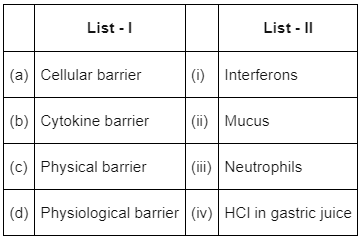
Choose the correct answer from the options given below :
Which one of the following immunoglobulins does constitute the largest percentage in human milk? [2015 RS]
Which is the particular type of drug that is obtained from the plant whose one flowering branch is shown below? [2014]
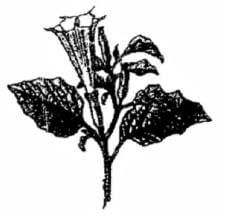
At which stage of HIV infection does one usually show symptoms of AIDS: [2014]
MALT constitutes about ________ per cent of the lymphoid tissue in the human body.
Asthma may be attributed to:
|
65 videos|386 docs|202 tests
|














